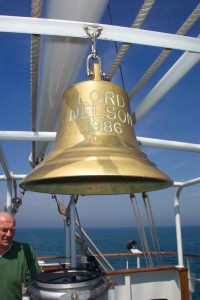STS Lord Nelson was two years in the making. Commissioned by the Jubilee Sailing Trust she would be the ‘flagship’ for the Jubilee Sailing Trust’s mission to enable people with disabilities to sail. Early trials aboard the barque Marques, the brig ‘Royalist’ and subsequently the brigantine Soren Larsen, enabled Colin Mudie to design a ship that would meet requirements.
In the summer of 1984 enough funds had been raised to enable a start on the building of Colin Mudie’s design no 342, Lord Nelson.
A contract was awarded to James W Cook, and the decision announced by Lady Donaldson, then Lord Major of London at a press conference in July 1984. The ship was to be constructed at Wivenhoe, Essex.
 Work began in earnest. The keel of the ship was laid in October 1984 after funding was secured through a generous donation from Sir Jack Hayward. Sir Jack performed the keel laying ceremony on a date which was chosen to be as close to Trafalgar Day as possible, the day in 1805 when Admiral Lord Nelson achieved his most famous victory.
Work began in earnest. The keel of the ship was laid in October 1984 after funding was secured through a generous donation from Sir Jack Hayward. Sir Jack performed the keel laying ceremony on a date which was chosen to be as close to Trafalgar Day as possible, the day in 1805 when Admiral Lord Nelson achieved his most famous victory.
Many decisions had to be made about the final layout of the ship, to enable her to be functional and practical for people of all physical abilities. It was almost a year after the formal keel laying that the ship was launched, by Lady Aitken whose late husband, Sir Max Aitken’s generous donation had enabled the JST to set up its first office in London.
Lord Nelson was now afloat, but was no means ready to take voyage crew. She now entered the fitting out stage of her construction as she made her first voyage to the fitting out basin. The deck was covered with ply and nine miles of teak was laid on top. Deckhouses were installed, engines and generators fitted, along with most of the wiring and plumbing.
 Unfortunately, it was not all ‘plain sailing’ from then onwards. J W Cook’s financial position deteriorated rapidly and the company went into voluntary liquidation. With Lord Nelson only half finished and the naming ceremony looming, the decision was taken to move Lord Nelson to Vosper Thornycroft’s yard in Woolston, Southampton.
Unfortunately, it was not all ‘plain sailing’ from then onwards. J W Cook’s financial position deteriorated rapidly and the company went into voluntary liquidation. With Lord Nelson only half finished and the naming ceremony looming, the decision was taken to move Lord Nelson to Vosper Thornycroft’s yard in Woolston, Southampton.
Vosper Thornycroft worked hard to complete the work, for the naming ceremony which was attended by HRH Prince Andrew and Sarah Ferguson, who performed the ceremony, on the 4th July 1986.
Work was not complete however, and Lord Nelson returned to Vospers yard to be met with more uncertainty. Vospers were hit by an industrial dispute, which meant that once again Lord Nelson had to move.
Arrangements were made to take Lord Nelson to Coles Yard in Cowes where the remainder of the work was carried out.
On the 17th of October 1986, the newly completed Lord Nelson made her way out of Southampton and towards the challenge of changing lives for everyone who came on board.




